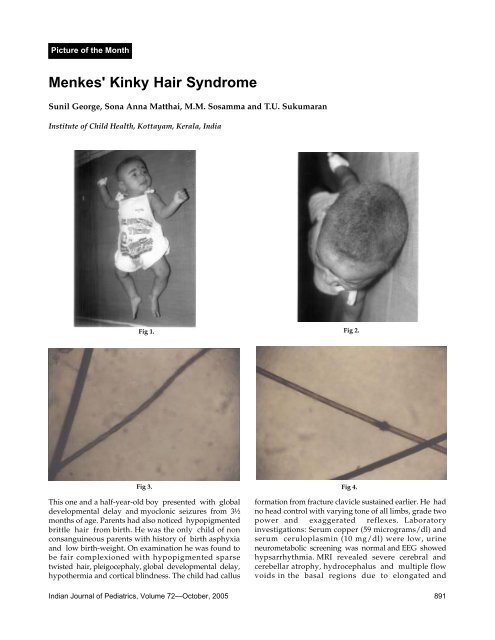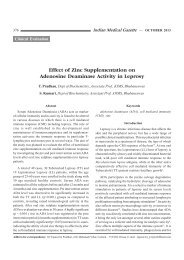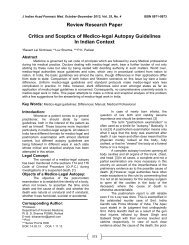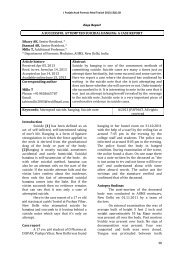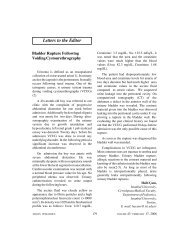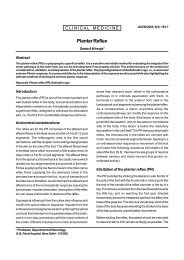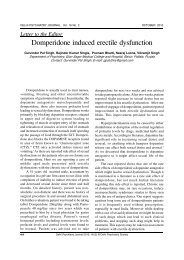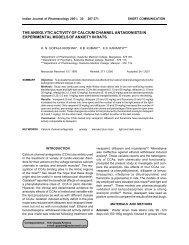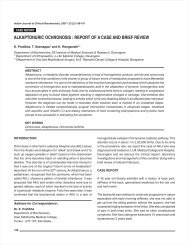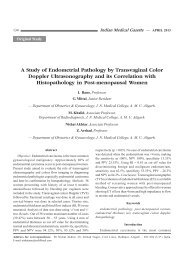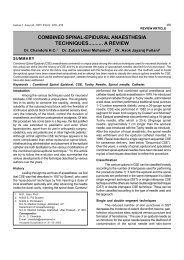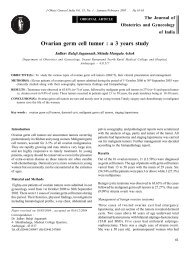Menkes' Kinky Hair Syndrome - medIND
Menkes' Kinky Hair Syndrome - medIND
Menkes' Kinky Hair Syndrome - medIND
Create successful ePaper yourself
Turn your PDF publications into a flip-book with our unique Google optimized e-Paper software.
Picture of the Month<br />
<strong>Menkes'</strong> <strong>Kinky</strong> <strong>Hair</strong> <strong>Syndrome</strong><br />
Sunil George, Sona Anna Matthai, M.M. Sosamma and T.U. Sukumaran<br />
Institute of Child Health, Kottayam, Kerala, India<br />
Fig 1.<br />
Fig 3. Fig 4.<br />
This one and a half-year-old boy presented with global<br />
developmental delay and myoclonic seizures from 3½<br />
months of age. Parents had also noticed hypopigmented<br />
brittle hair from birth. He was the only child of non<br />
consanguineous parents with history of birth asphyxia<br />
and low birth-weight. On examination he was found to<br />
be fair complexioned with hypopigmented sparse<br />
twisted hair, pleigocephaly, global developmental delay,<br />
hypothermia and cortical blindness. The child had callus<br />
formation from fracture clavicle sustained earlier. He had<br />
no head control with varying tone of all limbs, grade two<br />
power and exaggerated reflexes. Laboratory<br />
investigations: Serum copper (59 micrograms/dl) and<br />
serum ceruloplasmin (10 mg/dl) were low, urine<br />
neurometabolic screening was normal and EEG showed<br />
hypsarrhythmia. MRI revealed severe cerebral and<br />
cerebellar atrophy, hydrocephalus and multiple flow<br />
voids in the basal regions due to elongated and<br />
Indian Journal of Pediatrics, Volume 72—October, 2005 891<br />
Fig 2.
tortuous vessels. <strong>Hair</strong> microscopy showed trichorrhexis<br />
nodosa.<br />
This child clearly has Menke syndrome. It is an Xlinked<br />
disease due to an apparent defect in copper<br />
absorption from the gut, possibly, resulting from an<br />
inadequate transport mechanism. Deficiency of copper<br />
affects the Copper containing enzymes and is<br />
characterized by major motor seizures, progressive<br />
neurologic deterioration, abnormal hair, hypothermia,<br />
deformities of the skeleton, abnormally tortuous arteries<br />
and early death. 1<br />
Clinical manifestations include motor seizures, often<br />
myoclonic or generalized tonic clonic, with early onset<br />
within the first few months of life, most commonly in<br />
the neonatal period. Abnormalities of EEG include<br />
hypsarrhythmia and paroxysmal discharges.<br />
Hypothermia may be prominent. <strong>Hair</strong> is coarse<br />
,shortened and light coloured, and hair microscopy<br />
shows periodic narrowing (monilethrix), twisting (pili<br />
torti) and fragmentation ( trichorrhexis nodosa). Face is<br />
rounded with a depressed nasal bridge. Motor<br />
development is grossly retarded with poor head control<br />
and hypotonia, along with severe intellectual<br />
impairment. Blindness has also been seen in some<br />
patients.<br />
Serum copper and ceruloplasmin levels are low;<br />
radiographic studies of skeletal system demonstrate<br />
Sunil George et al<br />
flaring of the ribs and metaphyseal spurring.<br />
Arteriograms demonstrate tortuosity of cerebral vessels;<br />
Neuroimaging often demonstrates cerebral atrophy, low<br />
density cortical areas, enlarged tortuous vessels and subdural<br />
collections. Treatment with copper-histidine<br />
administered subcutaneously is effective, especially if<br />
started in the neonatal period as it prevents neurological<br />
deterioration. 2 But prognosis is poor and death occurs<br />
by 2-3 years due to other complications.<br />
Prenatal diagnosis is possible by chorion villus biopsy<br />
and estimation of copper content using radioactive<br />
copper uptake in fibroblasts. Molecular methods are also<br />
available.<br />
T.U. Sukumaran<br />
Professor of Pediatrics,<br />
Institute of Child Health (ICH),<br />
Gandhinagar, Kottayam, Kerala.<br />
E-mail-tusukumaran@hotmail.com<br />
REFERENCES<br />
1. Kenneth F S and Paul RD. Degenerative diseases primarily of<br />
grey matter. Pediatric Neurology : Principles and Practice, Vol<br />
II , 3 rd edn. Mosby 1999 : 833-835.<br />
2. Michael VJ. Neurodegenerative disorders of childhood. In<br />
Behrman et al, ed. Nelson Textbook of Pediatrics. 17 th edn.<br />
Saunders 2004 : 2034.<br />
892 Indian Journal of Pediatrics, Volume 72—October, 2005


